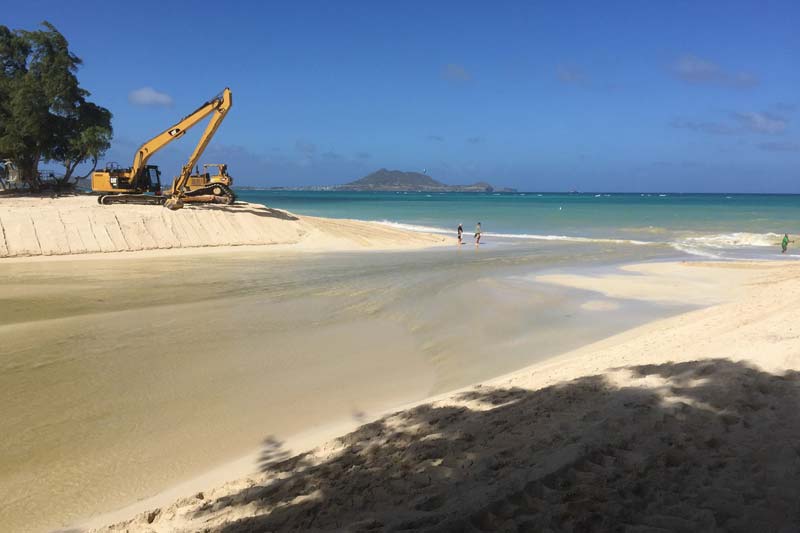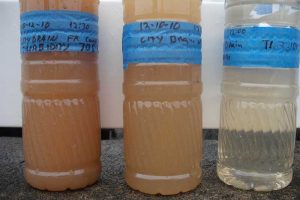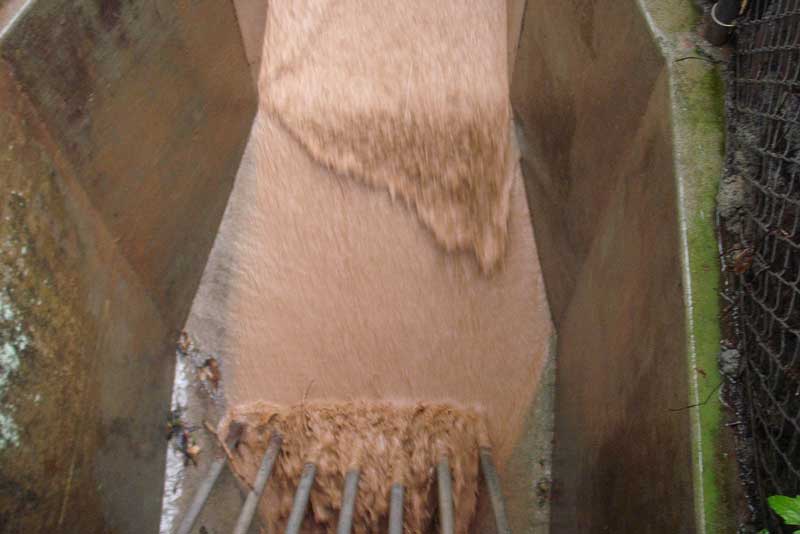Currently the City opens the mouth of the stream at Kailua Beach only sporadically to minimize flood threat from water impounded by the beach sand berm. Water surface elevations higher than 3.3 ft LMLLW result in the stream overflowing to adjacent residential areas. The number of days the stream remains open to tidal flow is directly dependent upon the height of the stream, the depth (not width) of the initial opening, and the length of time of the initial outflow until the rising tide flows back into the stream. The presence of high surf on the beach also appears to shorten the period of time the stream is open by increasing the quantity of sand pushed into the channel by wave action. The quantity of water exchange from the ocean is typically several times larger than the quantity of water entering the system from rainfall runoff. In most estuaries this salinity difference promotes mixing and maximizes exchange with the ocean. However, the Kaelepulu Stream has a shallow area that blocks the flow of salt water to the pond and greatly decreases the circulation efficiency. Ideally the city would open the stream mouth every month, timed properly to the tides so that it stays open for multiple days.


During rainfall events, runoff enters the estuary through 55 City storm drains and canals. The quality of the water entering the system is a function of the size and present land use of the sub-watershed serviced by each drain. The greatest contribution of sediment turbidity (cloudiness) and nutrients is from construction projects with open soil, particularly if these bare graded lands are on steep hill slopes. Turbid water entering the pond from construction sites will drop half (50%) of its sediment load within 100 minutes, but it takes about a week for 90% of the sediment to settle out of the water. During large storm events the brown water entering the Ocean through the stream mouth likely represents only a very small fraction of the sediment and nutrient load entering the pond from the upland pollutant source.
Drainages from City streets and canals also provide pollutant loads to the pond in the form of road gravel, trash, and green-waste and garbage discarded into open, and primarily hardened, channels. The 57.5 miles of City roads in the pond’s watershed contribute about 200 cubic yards of road gravel and tar residue to the pond each year — the equivalent of 20 large dumpsters of gravel every year.


Following every significant rain and runoff event, the storm drains introduce large quantities of debris to the pond, a portion of which floats on the surface and collects on windward shores of the pond. Floating debris is removed on a monthly basis by the ELRA clean-up crew. Typically, about half of the material removed is vegetative matter (primarily tree trimmings and coconuts) and half is floating plastics and cans. Each of the five open channels draining to the pond transports an abundance of yard cuttings and garbage to the pond.
Mangroves have been successfully removed from the Kaelepulu wetland, pond, and stream but these areas are continually re-seeded from mature mangrove colonies along the banks of the upper Kawai Nui Stream. A 2016 State/City project removed a large quantity of mangrove along the upper Kawai Nui Stream, but it is rapidly growing back. The mangroves increase the chance of flooding, overgrow native flora and fauna habitats, provide roosting for non-native birds, and result in water with low dissolved oxygen, low pH, high turbidity, and high tannin content. Permanent removal of the mangroves is seen as a necessary positive management action to protect the estuary ecosystem.
Sewage inflow to the system has been a concern in the past. Prior to completion of the Kailua Waste Water Treatment Plant (1966), secondary treated sewage flowed directly into Kaelepulu Pond. Repair and re-lining of the community sewers in the early 2000s is believed to have sealed leaky pipes that may have contributed to groundwater pollution. A sewage pump station located on the bank of Kaelepulu Pond discharged raw sewerage to the pond numerous times in the 1990s and early 2000s during heavy rainstorm events when stormwater entering the sanitary sewer system overwhelmed the capacity of the pumping system. City improvements to control stormwater inflow to the sanitary sewer system and upgrades to the lift-pump station have limited the overflow to a single occurrence in the past 10 years.
A number of studies conducted over the last three decades by the University of Hawaii, USGS, the City, and the Department of Health have searched unsuccessfully for chemical and sewage pollutants within the estuary system.
Continue reading: Problems & Solutions